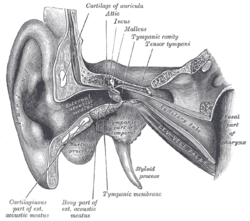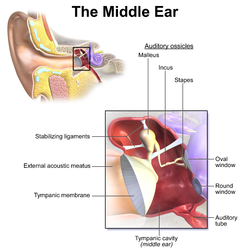| Eustachian tube | |
|---|---|
 External and middle ear. Eustachian tube labelled as auditory tube. | |
 Middle ear, with auditory tube at bottom right | |
| Details | |
| Pronunciation | /juːˈsteɪʃən/ |
| Precursor | First pharyngeal pouch |
| Identifiers | |
| Latin | tuba auditiva, tuba auditivea, tuba auditoria |
| MeSH | D005064 |
| TA98 | A15.3.02.073 |
| TA2 | 6926 |
| FMA | 9705 |
| Anatomical terminology | |
The Eustachian tube (/juːˈsteɪʃən/), also called the auditory tube or pharyngotympanic tube,[1] is a tube that links the nasopharynx to the middle ear, of which it is also a part. In adult humans, the Eustachian tube is approximately 35 mm (1.4 in) long and 3 mm (0.12 in) in diameter.[2] It is named after the sixteenth-century Italian anatomist Bartolomeo Eustachi.[3]
In humans and other tetrapods, both the middle ear and the ear canal are normally filled with air. Unlike the air of the ear canal, however, the air of the middle ear is not in direct contact with the atmosphere outside the body; thus, a pressure difference can develop between the atmospheric pressure of the ear canal and the middle ear. Normally, the Eustachian tube is collapsed, but it gapes open with swallowing and with positive pressure, allowing the middle ear's pressure to adjust to the atmospheric pressure. When taking off in an aircraft, the ambient air pressure goes from higher (on the ground) to lower (in the sky). The air in the middle ear expands as the plane gains altitude, and pushes its way into the back of the nose and mouth; on the way down, the volume of air in the middle ear shrinks, and a slight vacuum is produced. Active opening of the Eustachian tube (through actions like swallowing or the Valsalva maneuver) is required to equalize the pressure between the middle ear and the ambient atmosphere as the plane descends. A diver also experiences this change in pressure, but with greater rates of pressure change; active opening of the Eustachian tube is required more frequently to equalize pressure as the diver goes deeper, into higher pressure.
- ^ Keith L. Moore; Arthur F. Dalley; A. M. R. Agur (13 February 2013). Clinically Oriented Anatomy. Lippincott Williams & Wilkins. p. 970. ISBN 978-1-4511-1945-9.
- ^ "Eustachian Tube Dysfunction or Blockage Symptoms & How to Clear". medicinenet.com. Archived from the original on 5 October 2017. Retrieved 6 May 2018.
- ^ Eustachian tube at Who Named It?